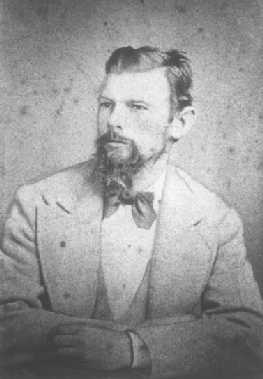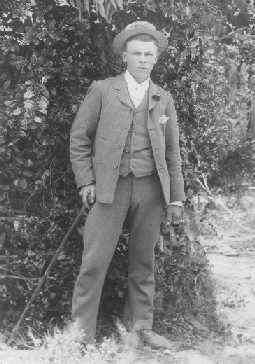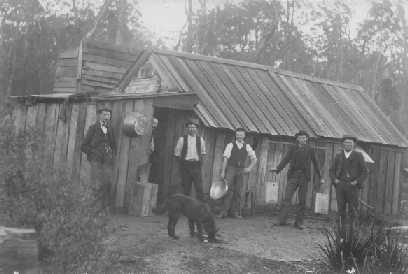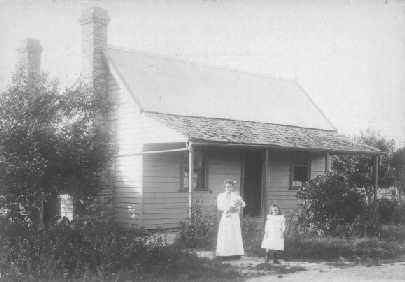
The Dobbin Family
THOMAS DOBBIN, the tanner, was born, in County Sligo, about 1770
and had four children. The eldest was born in 1800 and named Thomas, after his father.
Young Thomas became a militia officer holding the rank of Lieutenant and occasional merchant, and married Matilda Amanda Malvenia Proctor; daughter of a fellow militia officer, Captain Thomas Proctor and his wife Eliza Ann Jones, about 1838.
They had nine children, five sons and four daughters. Griffiths valuations of 1858 mentions Lt Thomas Dobbin as the occupier on lease from Captain Meredith, of houses, land, and offices on Coney Island in Sligo Bay, officially described as Inishmulclohy, in Killaspugbrone Parish, Sligo. He died on November 20, 1860, on Coney Island and he was buried in Saint John's Churchyard, in Sligo, three days later.
His brother, Abraham Dobbin, was a wine and spirit merchant, listed in the Sligo Directory for 1839 at 33 Wine Street. He lived some ten miles west of the city, on Farm Hill in the neighbouring county of Mayo.
He married Magdalene Welsh, a widow, (nee Irvine) at St John's Church on March 3, 1852, when he was about 45 years of age.
The Sligo Independent of Saturday, January 22, 1870, carried his obituary:
"He walked into Union Street, his business premises, from his residence at Farm Hill on the morning of his death.... He was Mayor of Sligo in 1861 and chief magistrate from 1862 until his death. He was buried at St John's on Tuesday last, the chief mourner, his brother John of Liverpool".
After her husband's death, Matilda Proctor Dobbin decided to join her eldest son, John Scott Dobbin already in Australia after having fought in the Maori Wars in New Zealand.
With her children, Bessie 18, Martha 15, Abraham 10, William Edward Jones, 8, Thomas 6, and Mary Ann, 3, she took passage on the the Flower of the Forest which departed from Liverpool on February 8, 1861, and arrived in Melbourne more than four months later on June, 17.
Mary Ann died at 77 Johnston Street, Collingwood, on August 26, 1861 and was buried the following day at the Melbourne General Cemetery.
William married Amelia Shoman at Bendigo, which was then known as Sandhurst, at Saint
Paul's Church of England on June 30, 1875. They had ten children, all but one daughter
survived to adulthood.
William Newcomb Dobbin, the second child of William Edward Jones Dobbin and Amelia Matilda Shoman, was born at Bendigo in the state of Victoria, on August 2, 1878. He spent his early childhood years in the gold-field towns of Bendigo and Ballarat but when he reached school age his family had moved to Melbourne and his education began at the Richmond State School.
His first job as a baker's boy in Ringwood included delivering bread by bicycle, and that was how he met Eliza Jane Maggs.
When he was 17 he decided to go to Western Australia. In 1895 he embarked on a ship
named the Inaminka which carried a deck cargo of draught horses. While crossing the
Great Australian Bight the vessel hit a severe storm and three of the fifteen horses on
deck were killed.
He found work in a timber camp in the Southwest, near Albany, and lived in a hut made of palings for a time, with five other men. While he was there an itinerant Indian photographer took a picture of the hut with its inhabitants standing outside.
Near the turn of the century his mind turned to thoughts of marriage. He returned to Victoria and proposed to Eliza Jane. Thomas Hagger in the presence of George Maggs, the bride's brother, and Elizabeth Frances Bell married them on March 14, 1900, at the Ringwood Church of Christ in Lilydale Road.
William and his bride returned to Western Australia on a ship called the Oruba and when their first child was born in Denmark, on January 18, 1901, he named her Vera Oruba Dobbin. Eliza Jane found the living conditions very rough and because of poor health she returned to Victoria when Vera was three months old. William followed on a ship called the Suvic.
 Their
second child, Cyril William Dobbin was born in Ringwood in October 1902 where William
worked in an orchard owned by his father-in-law, Sam Maggs. He purchased an area in Wonga
Park Road, now Kalinda Road, north of the creek. He also worked in a pottery, and in the
1905 Sands and McDougall directory he is listed as a brick and tile maker.
Their
second child, Cyril William Dobbin was born in Ringwood in October 1902 where William
worked in an orchard owned by his father-in-law, Sam Maggs. He purchased an area in Wonga
Park Road, now Kalinda Road, north of the creek. He also worked in a pottery, and in the
1905 Sands and McDougall directory he is listed as a brick and tile maker.
In 1917 he rented premises in Main Street, which is now known as Whitehorse Road. A shop between A.C.Beilby's store and McAlpin's office on the corner was opened as "The Railway Fruit and Confectionery Palace", and a shop in Melbourne Street, at the rear of the Main Street shop, became "The Fernery Refreshment Rooms". Three more children were born in Ringwood; Leonard Suvic in 1905, Clarence Newcomb in 1907, and the youngest; a daughter named EIvie Olive in 1909.
A fruit shop in Melrose Street, Sandringharn, "The Covent Garden Fruit Palace", was purchased in 1921 and later taken over by his son Cyril. During the early 1930s his marriage failed and he went to Williamstown and opened a florist shop in the name of Walter Dobson, which did very well. He married again and settled down to a life of retirement in Prahran, but his second wife, Elsie Fritzlatf, formerly Mrs Wilson, died unexpectedly and he was left alone once more. His eyesight deteriorated badly in his later years and he eventually entered the Mair Street Home for the Blind in Brighton where he died on May 12, 1960.
Vera Oruba Dobbin Laird, daughter of William and Eliza, recorded her story on November 13, 1977:
When I was a child we lived on an orchard in Ringwood, owned by my grandfather, Samuel Maggs. The next property was owned by Mr Gill, who had a son named Marcus and a daughter named Isobel. My brothers Cyril and Len were children. On the opposite side of the road a family named Cutts lived and their daughter, Vicky took me to school when I started after Easter 1908 at the Croydon State School. When my Uncle Samuel William Maggs married Lilian Schuhkraft on June 21, 1911 I was their flower girl.
I wore a white dress with a lace top threaded with ribbon and carried a basket of violets. In December I left school and went to work in the orchard. Then my grandmother, Eliza Ann Maggs had a stroke, so I went to work for her and also attended a part-time dressmaking course at Swinburne until this was interrupted by a serious illness. In 1917 my parents opened a confectionery shop in Main Street, opposite the railway station. My cousin Lily Collier and I worked in the shop and it was here that I became acquainted with Alexander Laird. A second shop selling fruit was opened almost opposite the railway crossing at Bedford Road, which was sold in November 1920 to Alick. We planned to marry and operate the shop but my parents objected to the marriage. A friend of Alick's, Dave Stewart, owned the Covent Garden Fruit Palace in Melrose Street, Sandringham and when he came to Ringwood to visit Alick, my mother learned that his business was for sale and in 1921 bought it from him.
I worked in that shop, and helped with the housework until May 1923 when I married Alexander Francis Laird at the Hampton Church of Christ and after a brief honeymoon we went to live at Wallan where Alick worked for the Victorian Railways.
The story of Thomas Dobbin and his family would never have been told on these shores if it weren't for the help of Malcolm Laird, a direct descendent, who contacted us by e-mail.
Malcolm and his wife Lottie live in Victoria, Australia.
Malcolm wrote: I would be delighted to hear from interested persons and to learn more of Coney Island where Thomas Dobbin died in 1860. I would be very pleased to hear if tombstones exist in St. John's Churchyard for these people, or obtain photographs, video footage or copies of paintings and maps relating to the families and places. All communications will be promptly answered.
You can contact Malcolm and Lottie at: mall@melbpc.org.au